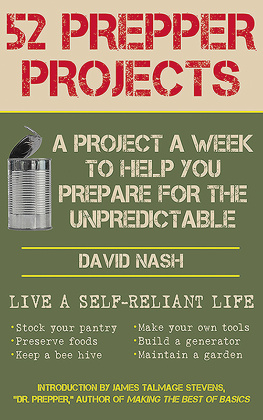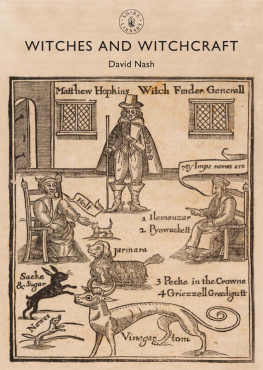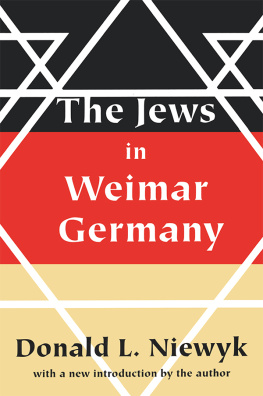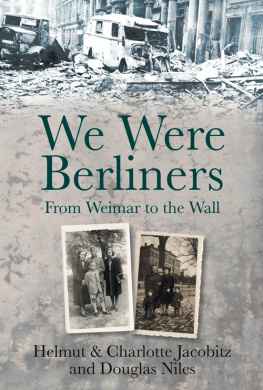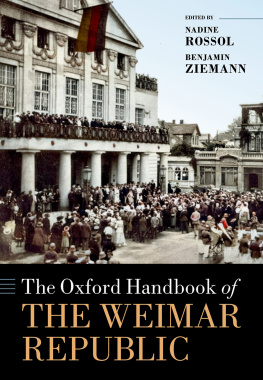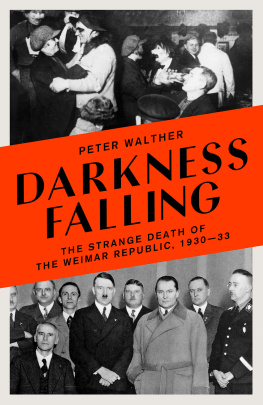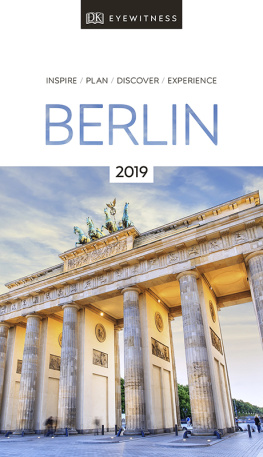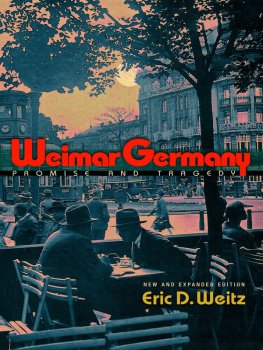Nash - A Walk Along The Kudamm: Playground and Battlefield of Weimar Berlin
Here you can read online Nash - A Walk Along The Kudamm: Playground and Battlefield of Weimar Berlin full text of the book (entire story) in english for free. Download pdf and epub, get meaning, cover and reviews about this ebook. year: 2015, genre: Non-fiction. Description of the work, (preface) as well as reviews are available. Best literature library LitArk.com created for fans of good reading and offers a wide selection of genres:
Romance novel
Science fiction
Adventure
Detective
Science
History
Home and family
Prose
Art
Politics
Computer
Non-fiction
Religion
Business
Children
Humor
Choose a favorite category and find really read worthwhile books. Enjoy immersion in the world of imagination, feel the emotions of the characters or learn something new for yourself, make an fascinating discovery.
- Book:A Walk Along The Kudamm: Playground and Battlefield of Weimar Berlin
- Author:
- Genre:
- Year:2015
- Rating:4 / 5
- Favourites:Add to favourites
- Your mark:
- 80
- 1
- 2
- 3
- 4
- 5
A Walk Along The Kudamm: Playground and Battlefield of Weimar Berlin: summary, description and annotation
We offer to read an annotation, description, summary or preface (depends on what the author of the book "A Walk Along The Kudamm: Playground and Battlefield of Weimar Berlin" wrote himself). If you haven't found the necessary information about the book — write in the comments, we will try to find it.
Nash: author's other books
Who wrote A Walk Along The Kudamm: Playground and Battlefield of Weimar Berlin? Find out the surname, the name of the author of the book and a list of all author's works by series.
A Walk Along The Kudamm: Playground and Battlefield of Weimar Berlin — read online for free the complete book (whole text) full work
Below is the text of the book, divided by pages. System saving the place of the last page read, allows you to conveniently read the book "A Walk Along The Kudamm: Playground and Battlefield of Weimar Berlin" online for free, without having to search again every time where you left off. Put a bookmark, and you can go to the page where you finished reading at any time.
Font size:
Interval:
Bookmark:
A Walk Along The Kudamm
Playground and Battlefield
of Weimar Berlin
Brendan Nash
Illustrations by Ian Stuart Campbell
First Published 2015.
Copyright Brendan Nash 2015. All rights reserved.
How to use this Guide
The Kurfrstendamm is numbered up one side from Breitscheidplatz to Halensee and back down again, so this walk is about three kilometres round-trip and should take approximately two hours. It is recommended that you do this on a Sunday or Public Holiday if possible, as at all other times the street is so busy that you may not get the chance to pause and take in the detail.
In addition to the landmarks and stories along the route, the street is also peppered with , small brass blocks laid in the cobbles to remember the names of the victims of Nazi rule, outside the homes and workplaces they were taken from. These stones are not always easy to spot, and there are sadly too many of them to tell every individual story, but its worthwhile to take the time to pause and reflect.
This is, of course, not a definitive history records get lost, streets are renamed and people forget but a personal collection of stories that detail the history of a street through the Weimar era and beyond.
Introduction
The history of the Kurfrstendamm, known as the Kudamm, can be traced back hundreds of years. As early as 1542, Kurfrst Joachim II marked out a track to connect the royal hunting grounds of the Tiergarten to the large forests of the Grunewald. The track became a road and over the years it expanded and developed, but it wasnt until the 1870s that a plan to create a boulevard to match the splendour of Pariss Avenue des Champs-lyses was fully conceived. Funding for the venture was provided by a consortium of banks and businesses, however it was the establishment of a colony of millionaire villas in the Grunewald that secured its future. The 53 meter-wide avenue was laid-out in 1883, although it was the opening of a steam-tram line from the Zoo to Halensee, in 1886, that truly saw the birth of the boulevard.
The first part of the Kudamm to be established is now known as Budapester Strae, and runs from the Landwehrkanal to the Zoo. It was lined with five-storey apartment houses and the magnificent Hotel Eden. By the turn of the 20th century the remaining, and most substantial, section of the Kudamm had been completed, from the Zoo to Halensee.
The boulevard was not destined to be the exclusive preserve of the elite. Artists, architects, scientists, writers and musicians were changing the world, and the tastes and conventions of Imperial Germany were beginning to look outdated and stale in this rapidly-evolving new century. Cafes, restaurants, shops, cabarets and theatres sprung up along its length and in surrounding streets, challenging the old order of the established historic centre of Berlin, which lay to the east, and creating a new, vibrant, cultural focus in the west.
The Kudamm became the shop-front for this new era. Established businesses from elsewhere in the city opened branches in the street often taking a daring, more international approach. The concept of the department store had been born and was growing in popularity. Pavements became catwalks for the emerging fashions of the time, observed by the crowds thronging the cafes lining the avenue.
This first, golden era of the Kudamm was short-lived, for the world was soon at war.
By November 1918, everything had changed. Imperial Germany had been defeated in a long and devastating conflict, resulting in the abdication of the Kaiser and the declaration of a new Republic. The early months of this new Republic saw Berlin streets turned into battlegrounds; whilst political leaders jostled for power, a communist revolution was under way and by the time of democratic elections in January of 1919, 2,000 Berliners had been killed. The fledgling government was forced to flee the city and assemble 280 kilometres south-east, in the historic town of Weimar, to draft the new constitution that bore its name and changed the lives of the people of Germany.
By 1920, Berlin was the third largest city in the world and the largest in Europe. The Greater Berlin Act had encompassed all the surrounding neighbourhoods and suburbs, and overnight the population more than doubled, to 4.5 million the most populous the city has ever been. This exciting, bustling city boasted 120 newspapers, 40 theatres, and a wealth of cinemas and cabarets. The abolition of censorship enabled anything and everything to thrive.
The Kurfrstendamm bounced back, stronger than ever. The ground floors of apartment buildings lining the street were now almost exclusively used for commercial premises, the front gardens converted into cafe terraces, and some of the ornate plaster-work of the upper floors removed to provide additional advertising space. Class barriers had melted away and all sections of society happily rubbed shoulders on this expensive, wildly popular boulevard.
To have a residential address on the Kudamm even a fourth-floor walk-up in a rear block or Hinterhaus was to be seen to have succeeded.
As the 1920s roared on, resentment and hatred toward the new republican society grew. The catastrophic hyper-inflation of 1922 had wiped out the incomes and life savings of ordinary Berliners and left hundreds of thousands in poverty. In the west of the city, the decadent Kudamm, accused of being too American, and of promoting un-German values, was often the target for this rage. Demonstrations, rallies and even riots were more frequent, as successive governments foundered and fragile coalitions failed.
The loudest voices to be heard were those of the increasingly popular far right. In March 1927, the rising National Socialist (Nazi) party, under its local leader Joseph Goebbels, sent 600 men to the Kudamm in a show of strength. The Romanisches Caf was attacked and ransacked, and guests and passers-by were beaten. Another attack, in 1931, saw 1,500 Nazi party supporters take to the Kudamm at Jewish New Year, shouting anti-semitic slogans and attacking people as they left a synagogue. Jewish-run businesses were targeted and their customers assaulted.
In April 1933, with the Nazi Party in power and Adolf Hitler the Chancellor, a boycott of Berlins Jewish businesses began, focused on the shops and department stores of the Kudamm.
The ominous presence of this new far right government lifted slightly as the 1936 Berlin Olympic Games neared. The Nazis wanted the city to be seen to be welcoming to visitors attending the Games, to appear modern, cosmopolitan, European and inclusive. It was an illusion. Beggars and the homeless had been removed from the streets and interned in work camps on the outskirts of the city. That summer there were as many Olympic flags as swastikas flying from buildings on the Kudamm. For a while, the facade of peace and enjoyment returned to the street and some flavour of the mid-1920s re-surfaced.
It was not to last. The Nazis hated the Kudamm and everything it represented.
Many of the stars of its theatres and cabarets had already fled the country and their venues had been aryanised. Some writers and artists managed to flee to other European countries and the United States, but where could the ordinary Berliners go, and what would happen to their homes and businesses if they fled?
On the night of November 9th 1938, the homes, shops and businesses of Jewish people on the Kudamm and throughout the country were targeted and systematically destroyed: 100 people were killed and 30,000 imprisoned. It would come to be known as Kristallnacht (Night of Broken Glass), and signalled the beginning of a pogrom against certain sections of society considered undesirable in a National Socialist Germany.
Within a year, the country was at war for the second time in a generation.
Next pageFont size:
Interval:
Bookmark:
Similar books «A Walk Along The Kudamm: Playground and Battlefield of Weimar Berlin»
Look at similar books to A Walk Along The Kudamm: Playground and Battlefield of Weimar Berlin. We have selected literature similar in name and meaning in the hope of providing readers with more options to find new, interesting, not yet read works.
Discussion, reviews of the book A Walk Along The Kudamm: Playground and Battlefield of Weimar Berlin and just readers' own opinions. Leave your comments, write what you think about the work, its meaning or the main characters. Specify what exactly you liked and what you didn't like, and why you think so.


